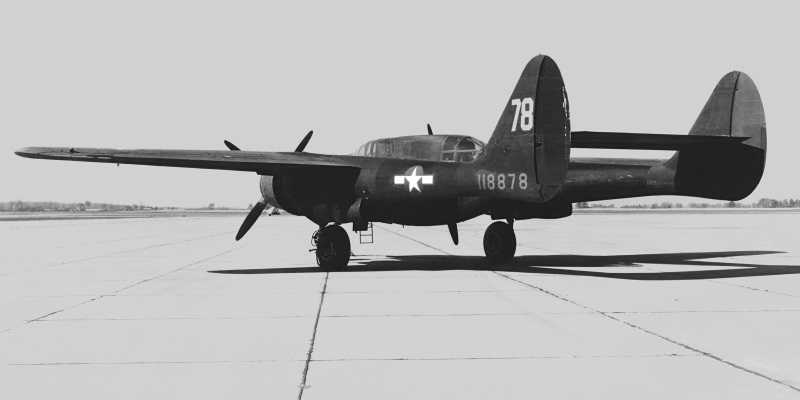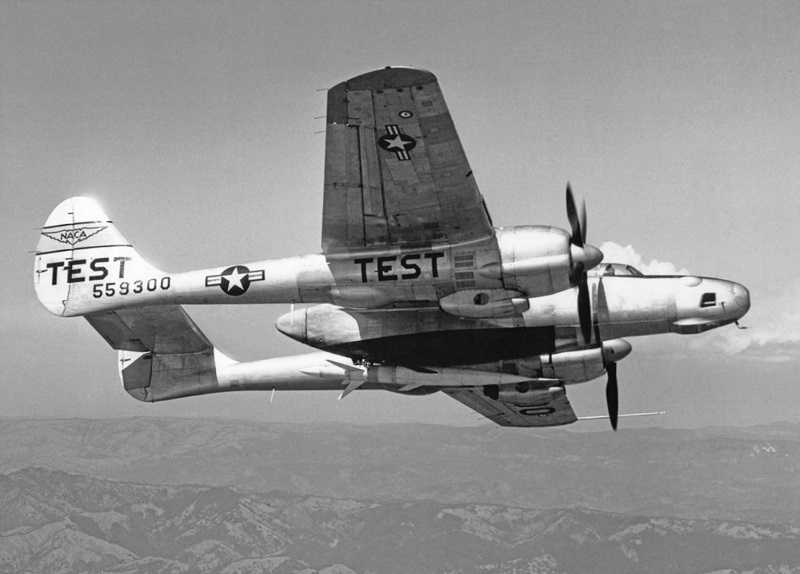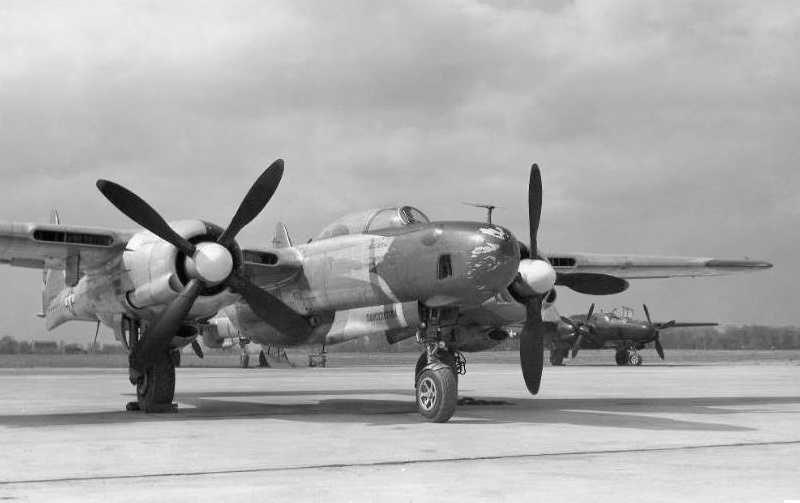[6] COMMENTS, SOURCES, & REVISION HISTORY
* Sources include:
- «Widow From Hawthorne» by Michael O’Leary, AIR CLASSICS, September 1996
through January 1997 - «Northop P-61 Black Widow» by Warren Thompson, WINGS OF FAME, Volume 15,
1999, 36:101
* Illustrations credits:
- BANNER: P-38F Lightning «Glacier Girl» / Chino CA USA / 2007 / author
- Northrop XP-61 Black Widow / USAAF?
- Northrop P-61C Black Widow / USAF Museum
- P-61 in the Marianas / USAAF?
- F-15A Reporter trials machine / NACA
- F-15A & P-61 of Project THUNDERSTORM / US Weather Service?
* Revision history:
v1.0.0 / 01 apr 17 v1.0.1 / 01 mar 19 v1.1.0 / 01 feb 21 v1.1.1 / 01 feb 22
BACK_TO_TOP
INDEX
| SITEMAP
|
| UPDATES
| BLOG
| CONTACT
| $Donate?
| HOME

[1] P-61 ORIGINS
* The roots of the Northrop P-61 went back to 1940, before America entered
World War II. Officers of the US Army Air Corps (USAAC) had gone to the UK
to be briefed on AI and night fighter development, and when they got back
home they pressed for the development of a US night fighter, envisioning a
twin-engine machine since the AIs of the time were bulky and heavy.
The chief of research of Northrop Aircraft, Vladimir H. Pavlecka, got wind
of the lobbying and worked with his boss, Jack Northrop, to come up with a
proposal to fill the need. The general concept they passed back to the Air
Corps was of a twin-boom night fighter, with a general configuration like
that of a Lockheed P-38 Lightning fighter, but much bigger, and powered by
twin Pratt & Whitney (P&W) R-2800 Double Wasp air-cooled two-row, 18-cylinder
radial engines.
The Air Corps liked the idea, though some alterations were suggested, and a
contract was issued for two prototypes of the «XP-61» in January 1941,
followed by a contract in March for 13 «YP-61» evaluation machines and a
static test airframe. A full-scale mockup was ready by April. By February
1942, 410 P-61s were on order from the US Army Air Forces — USAAF, which had
superseded the Air Corps in June 1941 — even though the first prototype
hadn’t flown yet: the US was now at war, and new weapons were needed
yesterday.
The first prototype performed its initial flight on 26 May 1942, with test
pilot Vance Breese at the controls. It was powered by twin P&W R-2800-10
radials providing 1,490 kW (2,000 HP) each. The aircraft was a hulking and
sinister-looking machine, and though the prototypes flew in natural metal,
the aircraft was named the «Black Widow».

The 13 YP-61s, all painted olive drab topside and neutral gray underneath,
were delivered in August and September 1943, with the initial production
«P-61A-1-NO» rolled out of the Northrop plant in Hawthorne, California, in
October 1943. (The «NO» stood for «Northrop / Hawthorne», but since all
P-61s would be built at that plant, that suffix will not be used further
here.) All but early production were painted gloss black, that proving much
harder to see at night than olive drab.
BACK_TO_TOP
[4] P-61C / XP-61D
* Although aircrews who had flown the P-61A and P-61B were generally
enthusiastic about the Black Widow, there were complaints that it needed
better performance. In November 1943, the USAAF told Northrop to go ahead
with the «P-61C», featuring turbocharged R-2800-73 radials providing a
maximum power of 2,090 kW (2,800 HP). Northrop engineers had originally
considered turbocharged engines, but worried they would cut into range and
endurance. However, the need for speed outweighed that concern.
Since Northrop was focused on the XB-35 flying-wing bomber at the time, work
on the P-61C was conducted at low priority, and in fact much of the P-61C
effort was farmed out to Goodyear of Akron, Ohio, which had previously
supplied subassemblies for Black Widow production. The first production
«P-61C-1» wasn’t rolled out until early 1945. It could be distinguished from
earlier P-61 variants by the prominent bulges for the turbochargers under the
engine nacelles. It also featured big A.O. Smith four-bladed paddle
propellers to handle the extra power. The P-61C was built with perforated
airbrakes above and below the wings to prevent a pilot from overshooting a
target during a fast intercept — but during a test of the airbrakes, they
tore the wings off the aircraft, the pilot managing to bail out safely, and
so they were rendered nonfunctional in all service aircraft.
Performance clearly improved, the machine being capable of 690 KPH (430 MPH)
at altitude, even though the empty weight of the aircraft had increased by
about 900 kilograms (2,000 pounds). Ceiling was raised to 12,500 meters
(41,000 feet), and climb rate was substantially faster as well. However, the
greater weight made the P-61C also less agile, heavier on the controls, and
reluctant to get off the runway.
The P-61C went into service with the USAAF in July 1945, but the war ended
before the variant could see combat. 41 were built in early 1946; more had
been on order, but the end of the war led to the cancellation of the orders.
* There was actually some waffling over the engine configuration of the P-61C
due to demands on P&W production, with two prototypes built featuring
alternative R-2800-77 engines under the designation of «XP-61D». Initial
flight of the first was in November 1944. The decision was made to go with
the P-61C configuration, and both XP-61Ds ended up being scrapped.
BACK_TO_TOP
[5] XP-61E DAY FIGHTER / F-15A REPORTER
* Work was also performed on a day fighter version of the Black Widow, with
two P-61Bs converted to the «XP-61E» configuration. The major change was the
complete redesign of the central fuselage to a more streamlined form with a
tandem-seat bubble canopy, the third crew position being eliminated and
increased fuel tankage included in its place. A ladder was fitted to the
left side of the fuselage to allow the crew to get in and out. The four
20-millimeter cannon were retained, but the radar and turret were deleted,
four fixed 12.7-millimeter Brownings being fitted in the nose, with 300
rounds per gun.
The need for a new long-range escort fighter fell off after the program was
initiated, and so XP-61E development was conducted on a low-priority basis,
the first prototype not being completed until March 1945. The first
prototype had a canopy that hinged open to the left, and its Brownings were
fitted in a 2×2 arrangement; the second had a canopy that slid backward to
open, and the Browning were arranged in a horizontal line. The second XP-61E
was lost in a take-off accident in April 1945, the pilot walking away
unharmed but the aircraft a total loss.
* Performance of the XP-61Es was good, but the new North American P-82 Twin
Mustang was much more impressive, and so the XP-61E effort was abandoned.
However, the work did not go to waste. In the summer of 1945, the surviving
XP-61E was modified to an unarmed photo-reconnaissance configuration, with
the guns yanked, the airbrakes on the wings removed, and a camera nose
installed. Six cameras could be fitted in a range of possible
configurations; the camera nose added 23 centimeters (9 inches) to the length
of the aircraft. Initial flight of the «XF-15» — the «F» meaning «foto» in
those days — was on 3 July 1945. A second XF-15 was modified from a P-61C,
with the same general arrangement but the turbocharged engines.
The USAAF was enthusiastic enough to order the type into production with the
turbocharged engines as the «F-15A Reporter» in June, even before the first
flight of the XF-15. With the end of the war, most of the order was
canceled, with only 36 delivered. All were «F-15A-1» machines except the
last, which was an «F-15A-5», featuring a modified camera nose. The F-15As
retained the two-seat configuration of the XP-61E, with the back-seater
operating the cameras. The back-seater also had a set of simple flight
controls to allow him to spell the pilot.

Most operated out of Japan, performing an administrative photo-survey of the
country under the «Post-Hostilities Mapping Program» — which also mapped the
Korean peninsula, providing information that would come in handy in 1950,
when the Korean War broke out. F-15As also mapped the route of the Bataan
Death March in the Philippines to support war crimes trials. In 1948,
when the modern USAF designation scheme was introduced, the F-15As were
redesignated «RF-61C». The last were removed from service in the spring
of 1949, with most of them scrapped.
* The P-61 remained in service for a few years after the war, being replaced
by the F-82F Twin Mustang, which itself was quickly replaced by the Northrop
F-89 Scorpion. Some Black Widows were used for trials, including engine
tests, test launches of various missiles and drones, as well as test drops of
aircraft aerodynamic models, and ejection-seat trials. The ejection-seat
test machine, incidentally, was named JACK-IN-THE-BOX.

In 1946 and 1947, a number of P-61s and F-15s were employed in the US Weather
Service’s Project THUNDERSTORM, intended to research violent weather, with
armament removed and the aircraft fitted with instrumentation. They were
given some flashy markings for the occasion. They flew, of course, into
thunderstorms, often being struck by lightning, and sometimes suffering
damage from hail. No doubt the flights could be exciting — not necessarily
in a good sort of way — but no aircraft were lost, and the exercise provided
valuable data.
A few F-15As were sold off to civilian operators, to be used as photo-mapping
machines into the 1950s, and at least one flew in the civil fire-fighting
role. One P-61C was flown by Northrop as a chase plane. No Black Widows
remain in flight status, though a few still survive as static displays.
BACK_TO_TOP
























